Fractal Design Core 500 ITX Case Review
Pros
Cons
Rating
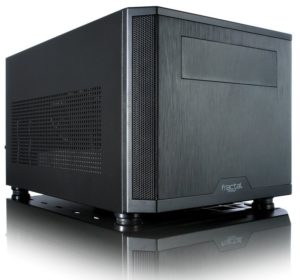
Introduction
Here at The Tech Buyer’s Guru, we really like reviewing cases, and we’re particular fans of the ITX genre; in fact, we have a whole buyer’s guide dedicated to ITX systems, along with nearly half a dozen step-by-step ITX assembly guides. All of that means we have a pretty good handle on the ITX market, as well as what features can make or break an ITX case design. So we were intrigued when Fractal Design released the Core 500; it looked to have just the right combination of features.
The very first thing to know about the Core 500 is that it’s quite inexpensive, with an MSRP of just $60. That puts it right in the middle of some tough “shoebox” competition from the likes of Cooler Master (with its Elite 130) and SilverStone (with its SG13 and SG08). And while it’s slightly larger than all three of those competitors, for most users, the Core 500 is a far better case overall, for reasons we’ll detail in this review.
Description and Features
The Core 500 measures 9.8″ wide, 8.4″ tall, and 15.0″ deep (or 250mm x 213mm x 380mm). Its basic design isn’t all that different from many cases that have come before it. A few drive bays in the front, accompanied by a hollowed-out interior for the rest of the components. But it’s the specific layout Fractal Design chose that makes it so special. While most cases in this category feature a front-mounted intake fan, which requires that the power supply be stuffed above the CPU, Fractal Design took a bold step in the right direction by skipping the front intake fan all together. A recipe for overheating, right? Well, you might think so, but the Core 500 is actually a much better performer due to its wide-open interior, aided by a fully-vented top panel and a big 140mm exhaust fan. No other case features quite this layout, and it really is ideal.
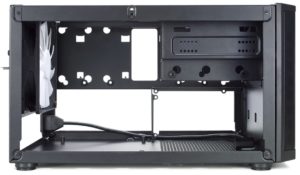
And while the Core 500 is quite moderately priced, Fractal Design didn’t make it feel cheap. A smooth matte black paint job, clean interior edges, and a well-organized assortment of parts makes it clear that this case belongs to the Fractal Design family. We also liked its well-written manual, although as we’ll discuss on the next page, we think Fractal Design actually gets the assembly steps out of order, leading to an impossible build scenario, a rare mis-step given the fantastic attention to detail elsewhere.
The Core 500 can fit plenty of gear, though as always the devil’s in the details. Fractal Design lists the following possibilities: three 3.5″ hard drive positions, three 2.5″ drive positions, one 5.25″ external bay, and room for coolers up to 170mm tall and ATX power supplies 170mm long. OK, that’s fine. But then come the warnings, right off the spec sheet: motherboards with SATA ports that are angled 90 degrees may conflict with installation in the case, your 170mm ATX PSUs must be non modular (while modular units must be under 160mm), and graphics cards longer than 170 mm will not fit with PSUs that exceed 170 mm. Oh golly, that’s complicated, isn’t it? Well, we applaud Fractal Design for being up front about all of this, because frankly, most of its competitors’ offerings suffer from similar limitations, but no mention is made of these issues on their spec sheets. So in this review, we’ll share some of our own thoughts about the gear you should actually use if you want a good experience building with the Core 500.
To put the case to the test, we loaded it up with the following components:
- CPU: Intel Core i5-6600K
- Motherboard: Gigabyte GA-Z170N-Gaming 5
- Memory: Corsair Vengeance LPX 2x8GB DDR4-3000
- Video Card: EVGA GeForce GTX 980 SC 4GB
- Solid-State Drive: Samsung 850 Evo 500GB
- Optical Drive: Samsung SH-224FB
- Case: Fractal Design Core 500
- Power Supply: EVGA Supernova 650 GS
- CPU Cooler: Arctic Freezer i32
- Operating System: Windows 10 OEM Disc
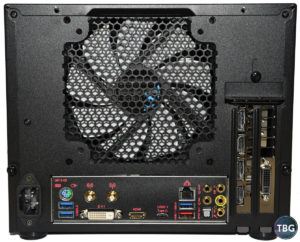
The good news: everything we used fit (just barely), and we’ll make special note of EVGA’s excellent Supernova GS series of power supplies. These units are just 150mm long, feature fully-modular cables, and offer Gold-rated output of up to 650W. If you’re building up a system in the Core 500, do yourself a favor and just get the Supernova 550GS or 650GS. Seriously. Want to jam a 160mm- or 170mm-long unit in this case because Fractal Design said you could? Good luck with that! You already know that modular 170mm units will mean you can’t run a decent video card, while 160mm units will create a huge hassle when it comes to cable management. Oh, and non-modular units? That’s a recipe for extreme frustration in a case this size. They’re easier to design around because they have cable outputs at just one end of the box, but they’re a terrible choice for any ITX system, and ITX case manufacturers should stop using them as a crutch. Fractal Design isn’t the first manufacturer to offer this convoluted advice, but we sure hope it’s the last.
OK, off our high horse. Now we’ll jump ahead a bit, showing you a photo of the rear of the case shown above, which illustrates what our system looked like once completed. But it also serves to highlight the placement of the big 140mm exhaust fan. It draws heat away not just from the CPU, but from the rear of the video card as well, which is critical if you’re using a model with an open-air cooler (something that most video cards use nowadays). You can also see in this photo that the case has some room towards the top of the motherboard above the power plug. That’s critical for fitting large tower-style coolers, which typically could hit the side of an ITX case. Fractal Design advertises that the Core 500 can fit 170mm-tall coolers, which is true, but more important, it can do so without the side of the cooler sitting outside of the case! That’s what so many other ITX cases get wrong when trying to incorporate big air coolers: it’s not just about the height!
So let’s go ahead and step inside the box to see what it’s like to build up a system with the Fractal Design Core 500!
Assembly
Assembling a system in the Core 500 takes a little patience, a lot of dexterity, and a good bit of forethought. First you must install the 5.25″ optical drive and/or 3.5″ hard drive if you want to use the front bracket (installing the 5.25″ drive later is possible, but the 3.5″ drive will be completely “boxed out” at that point). Then you’ll want to assemble your motherboard components outside of the case, in preparation for installation in the case.
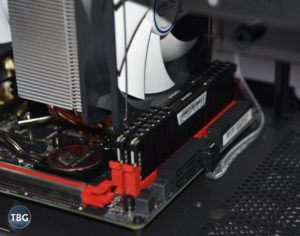
And this is where we’re just going to go ahead and say it: Fractal Design royally goofed up the Core 500 manual. User reviews and forums are full of comments about the design flaw in the Core 500 that makes attaching SATA cables impossible. Indeed, it’s a serious enough issue that Fractal Design has noted it on its website. The fact is, however, that you can easily use any motherboard in this case, but you can’t use a single one the way Fractal Design suggests. If you follow the manual and install the power supply first, it’s essentially impossible to insert a motherboard in the case, especially if it has anything other than the stock Intel low-profile heatsink attached. That’s because there’s only about 1cm of clearance between the motherboard and the side of the power supply, and to insert the rear I/O ports into the I/O panel, you need more than 1cm of wiggle room (that’s a technical term, of course!). So before you throw a fit (or even worse, throw your Core 500 out the window!), just take a step back, pull that power supply out, and calmly insert your motherboard. And keep in mind, you must have your cooler installed at this point, as there is no access to the underside of the motherboard once it’s installed in the case. While you’re at it, you might as well install your RAM modules as well, because doing so once the motherboard is inside the case is quite a bit harder.
Now, motherboards with side-facing SATA ports, like the Gigabyte model we used, do force you to use side-angled cables. But that’s not such a big deal, as such motherboards typically come with at least a couple. As you can see in the photo here, a 90-degree bend does indeed make it possible to fit your SATA cable in without encroaching on the power supply. Just make sure you wire up all your cables before you install the power supply. We should note, however, that motherboards with vertical SATA ports are an overall superior choice, and for that reason we strongly recommend that any builder looking at this case consider the excellent Asus Z170I Pro Gaming. We’ve used it in several builds, and it just can’t be beat in terms of layout, nor in features for the price.
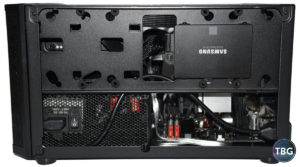
Assuming you’re able to get your motherboard installed by following our advice above, the rest of the build will go very smoothly. The power supply slips in right in front of the motherboard, and with our 150mm-long modular unit, cable management was an absolute breeze. We simply can’t imagine using a non-modular unit in this case, but apparently Fractal Design can, as it recommends them for anyone who wants to use a 170mm unit (i.e., anyone who is a glutton for punishment). Another great feature of the Core 500 are the side-mounted drive rails. There’s also a similar rail behind the front panel, but that one’s hard to access, so in a system with just two 2.5″ drives, the side-mounted rails are the ones you’ll want to use. They require just a few screws to attach the drives, and provide easy access to the SATA power and data cables attachment points.
As we mentioned on the previous page, the Core 500 provides support for just about any cooler you could imagine. We used the awesome Arctic Freezer i32, which at 150mm is a mid-sized cooler, but due to its excellent design, offers tremendous cooling capacity. It’s also the only cooler on the market so far that features a zero-RPM fan mode, much like the newest video cards and power supplies. We actually set up our Core 500 to run just a single fan at idle: its 140mm exhaust fan. And even then we could run it at under 500RPM, meaning the system was literally silent.
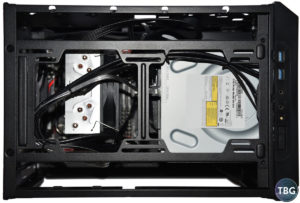
Now, you can install a liquid cooler in this case, up to 280mm long, in fact, but cabling becomes more difficult the bigger the cooler is, and with anything beyond 140mm, you definitely can’t install an optical drive. The top-down photo we’ve included here shows you the ample mounting area for a radiator, as well as the challenge in using this area when you have a tower cooler and optical drive installed. The great thing about this design with regard to air cooling is that the top panel is completely vented, providing unlimited intake air for your CPU cooler. And because the side panel is entirely vented as well, your video card will likewise have unlimited intake air potential.
Performance
We’ve built up a lot of ITX systems, including several intended for serious gaming. While the Core 500 isn’t the smallest ITX case around, in our opinion, it’s the smallest case on the market that can truly be considered an enthusiast-caliber gaming case. That’s because it not only fits ultra-high-end gear (i.e., a video card, CPU cooler, and power supply you need to actually push games to the maximum, it also works well once you’ve jammed all those components in. You see, there are smaller cases that could fit the components we used, but the Core 500’s immense vented top panel and high-performance and unobstructed 140mm exhaust mean that pushing these components to the limit doesn’t create havoc inside the case. No fans buzzing away at 100%, no components coming anywhere near their thermal throttling point, just pure gaming bliss.
We took a few measurements of the system at idle and at load, and came away very impressed. At idle, our system was literally below the noise threshold of our sound meter (measuring 30dB, the same as it was with the PC off!), and at load it came it around 38dB, depending on the particular application and fan curves used. All in all, there’s just no comparison between this and other ITX cases we’ve reviewed; the Core 500 is superior.
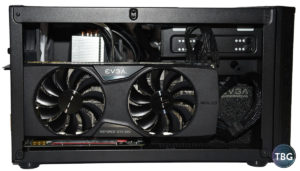
In the photo above, you can see our build fully assembled. Note how neatly all the cables can be routed behind the video card and above the power supply, keeping them out of the way of precious airflow. You can also see that much larger video cards could be used in this case, although we’d caution you that you’ll need to do some serious bending of power cables if you go for a really large model.
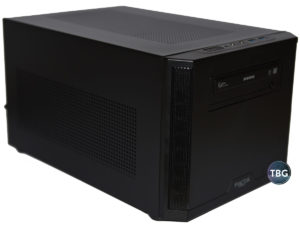
Conclusion
When it comes to the ITX market, there is thankfully a lot of choice. And that’s a good thing, because there isn’t just one use for the ITX format. Want a bookshelf PC or a PC to slip onto your media console? We’ve reviewed great options in both those form factors. But if you want to build a truly high-powered PC, you need a bit more breathing room, and that’s what the Core 500 delivers, in spades. From our point of view, it’s the ideal layout to support extreme components and extreme overclocking, and it comes with the added benefit of maintaining a very compact shoebox-style design.
As of our publication date, the Fractal Design Core 500 ITX is available for $59.99 from Amazon, which makes it a tremendous value. If you’d like to build your own PC using the Core 500, check out our Do-it-Yourself PC Buyer’s Guide for all the best component picks, updated monthly!

